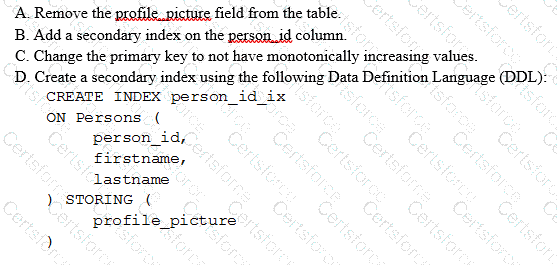Your existing application running in Google Kubernetes Engine (GKE) consists of multiple pods running on four GKE n1–standard–2 nodes. You need to deploy additional pods requiring n2–highmem–16 nodes without any downtime. What should you do?
You want to permanently delete a Pub/Sub topic managed by Config Connector in your Google Cloud project. What should you do?
You have an application that uses Cloud Spanner as a database backend to keep current state information about users. Cloud Bigtable logs all events triggered by users. You export Cloud Spanner data to Cloud Storage during daily backups. One of your analysts asks you to join data from Cloud Spanner and Cloud Bigtable for specific users. You want to complete this ad hoc request as efficiently as possible. What should you do?
You are planning to migrate your on-premises data to Google Cloud. The data includes:
• 200 TB of video files in SAN storage
• Data warehouse data stored on Amazon Redshift
• 20 GB of PNG files stored on an S3 bucket
You need to load the video files into a Cloud Storage bucket, transfer the data warehouse data into BigQuery, and load the PNG files into a second Cloud Storage bucket. You want to follow Google-recommended practices and avoid writing any code for the migration. What should you do?
Your customer has implemented a solution that uses Cloud Spanner and notices some read latency-related performance issues on one table. This table is accessed only by their users using a primary key. The table schema is shown below.

You want to resolve the issue. What should you do?

You need to deploy an application in Google Cloud using savorless technology. You want to test a new version of the application with a small percentage of production traffic. What should you do?
You have 32 GB of data in a single file that you need to upload to a Nearline Storage bucket. The WAN connection you are using is rated at 1 Gbps, and you are the only one on the connection. You want to use as much of the rated 1 Gbps as possible to transfer the file rapidly. How should you upload the file?
All development (dev) teams in your organization are located in the United States. Each dev team has its own Google Cloud project. You want to restrict access so that each dev team can only create cloud resources in the United States (US). What should you do?
Your web application has been running successfully on Cloud Run for Anthos. You want to evaluate an updated version of the application with a specific percentage of your production users (canary deployment). What should you do?
Youare configuring Cloud DNS. You want !to create DNS records to pointhome.mydomain.com,mydomain.com. andwww.mydomain.comto the IP address of your Google Cloud load balancer. What should you do?